Abstract
This study addresses the task of ecologically assessing the consequences of natural fires. Statistical data are presented on the carbon dioxide emissions in millions of tons and analytical data on the locations of peat fires, as well as modern methods of detection and control of peat and forest fires, divided into groups. An analysis of the works of leading Russian and international scientists and research organizations engaged in the search for methods of peat fire forecasting is also presented. Our aim was to develop a more effective method of preventing peat soil ignition by changing its physical and moisture characteristics. To that end, peat samples were selected in the Tver region. The laboratory equipment and the methodology of our experimental studies are described in detail, in which we simulated the natural climatic conditions in the center of the Russian Federation. This study provides a mathematical description of the process of spontaneous ignition, which occurs according to the following steps: a heat flow heats the surface to the ignition temperature, creating a self-heating zone; eventually, a wave of ignition (smoldering) capable of self-propagation is formed. We experimentally determined the spontaneous thermal ignition conditions in our experimental studies of the fire hazards of selected peat samples, where the test material was loaded in a cylindrical container made of brass net with a 0.8 mm mesh, of the dimensions 30 × 30 mm. Thermocouple elements were placed inside the container, fixing the temperature of the surface and the center of the sample, where the smoldering or ignition zone of the test material formed. We analyzed the results of our experimental studies on peat samples’ self-heating chemical reaction, leading us to draw conclusions about the possibility of fires on peat soil depending on its physical and chemical characteristics. We also offer recommendations that will improve peat soils’ fire safety, permitting agricultural crop production without a peat fire risk.
Keywords:
peat soil; bulk density; degree of decomposition; ash content; fires; ecology; carbon emissions; carbon; sulfur; iron 1. Introduction
Burning biomass produces a major global source of gas and dust emissions to the atmosphere and is considered one of the main ecotoxicological risk factors for human health.
Smoke from peat fires comprises an aerosol–gas mixture that includes CO, CO2, NO2, SO2, water vapor, and solid particles. Of these, 90% have sizes less than 0.1 µM, which include soot, ash, coal dust, and tar, products of combustible material components’ transformation. Acrolein and acetaldehyde are also present in the smoky air, exceeding the maximum permissible concentrations (MPCs), and these have hypoxic, hemotoxic, and neurotoxic effects on humans [1,2,3].
According to independent assessments by the Biodiversity Conservation Center, the total economic damage from wildfires is estimated to have reached RUB 10 trillion (USD 375 billion) [4].
According to research by the Geobiocenter of Munich University (Germany), when peat fires occur in the Russian Federation, 30–100 million tons of carbon dioxide are emitted into the surface layers of the planet’s atmosphere [5].
When areas are exposed to large wildfires or multiple small fires over a long time, permanent high-pressure zones form in these regions. Cyclones bypass those areas, leading to drier and hotter weather than usual in the fire-affected areas.
Fires of drained peat deposits may have negative ecological and climatic consequences for the population, ecosystems, and the economy as a whole. Moreover, natural fires release greenhouse gases into the atmosphere.
Peat fires increase the depth of seasonal soil freezing (due to soil burnout and reduction in the thermal effect, and, as a result, disturbance of the thermophysical parameters of soil layers), surface runoff, and soil degradation due to the increased water and wind erosion they bring over large areas.
As a rule, peat fires mainly arise where there are peat deposits that should have been recultivated, so the most effective solution to the problem of peat soil fires is to perform agricultural turnover. Accordingly, soils with high fertility and crop production cost less than low-fertility soils in the Central Non-Chernozem zone of the Russian Federation.
A plethora of methodologies are currently employed to detect and combat peatland and forest fires [6,7], which can be broadly categorized into several distinct groupings:
Detecting:
Fire detection
- (1)
- Ground patrols and observations: Forest rangers and firefighters regularly walk through areas, using binoculars, thermal imagers, and other equipment to look for smoke, fire or other signs of fire. Observation posts are set up on towers, masts and pavilions from which large areas can be covered.
- (2)
- Fire detection and observation of fire development using aviation: Airplanes and helicopters equipped with cameras and thermal imagers regularly fly over forest areas. This makes it possible to detect fires at an early stage and quickly assess their extent.
- (3)
- Detection of fires and observation of their development using space-based means: Satellites and specialized automated earth remote sensing systems provide overview images of large areas. These data are refined by airborne or ground-based means to determine the exact coordinates of fire centers.
Fire forecasting
- (1)
- Wildland Fire Assessment System [8]: In the United States and Alaska, data from 1500 weather stations are collected daily and used to assess current fire conditions. These data include information on temperature, humidity, wind speed and direction, and precipitation.
- (2)
- Fire Hazard Maps [9]: These maps are developed based on current and past weather and the presence of combustible material. They show potential risk areas and help in planning preventive measures.
- (3)
- Next-Day Weather Forecast [10]: Meteorological services provide weather maps that show parameters such as wind speed and direction, rainfall, temperature and relative humidity. These data are important for assessing conditions that may favor the spread of fire.
- (4)
- Greenness Maps [11]: These maps show the distribution of vegetation and its potential flammability. They help to identify areas at high risk of fire and plan protective measures.
- (5)
- Greenness Maps, dividing vegetative combustible material into pyrological types—fuel models [12]: Peat soil belongs to the second group of vegetation combustible materials. This means that it can smolder and the peat surface is the main source of ignition.
- (6)
- VCM Moisture: Risk of fire is directly related to the moisture content of the vegetation. Dry vegetation is easily ignited and burns with high intensity.
- (7)
- Keetch–Byram Drought Index (KBDI) [13]: This index is used to predict the likelihood and severity of forest and peatland fires. It is based on rainfall, air temperature, and other meteorological factors.
- (8)
- Haynes Index (also known as the Lower-Atmosphere Severity Index) [14]: This index, developed by meteorologist Donald Haynes, estimates the probability of large forest fires based on the stability and moisture content of the lower atmosphere. The index takes into account temperature differences between different levels of the atmosphere and moisture content to help predict conditions favorable for fire initiation and spread.
In Russia, the methodological basis for fire danger assessment and forecasting was introduced by Nesterov V.G., Sokolova G.V. et al. [15,16]. Their methodology involves calculating the complex index (CI) based on meteorological data, thereby determining the change in the moisture content of combustible material (CM).
In Canada, a territory with similar natural conditions to those of Russia, the CFFDRS system (Canadian Forest Fire Danger Rating System) was developed in 1968 [17]. Among its four subsystems [18] are the FWI (Fire Weather Index) and FOP (Fire Occurrence Prediction), used for forecasting [19,20].
The FWI was developed based on 17 typical complexes of vegetative combustibles in Canada [21]. Its calculation reproduces the ignition process. First, the moisture contents of different layers of combustible materials (CMs) are determined, reflecting the stages of ignition and fire maintenance (surface, deep). On this basis, the fire intensity and CM stock that can ignite are estimated. Finally, they are combined in the FWI, which is used to estimate the depth of CM burning and the subsequent difficulties of extinguishing the fire. FWI maps are drawn daily with a forecast for the next two weeks [22], and monthly for the next four months [23].
In the USA, the NFDRS—National Fire Danger Rating System—is used. This was created in 1972 and subsequently updated in 1978 and 1988 [24]. The system is an abstract model of various factors influencing wildfire occurrence. The object of ignition within the model is subdivided into two types—live fuel CM and dead fuel, which maintain moisture contents differently in response to changes in external environmental conditions. Depending on their ratio, 20 typical vegetation site models have been developed [25]. A multifaceted fire hazard assessment is performed for these according to a structured methodological sequence based on site descriptions, with meteorological, geomorphological, and vegetative elements forming the structural basis for fire hazard interpretation.
The model both evaluates the current situation and forecasts fires for 3 days ahead [26]. It is used to differentiate hazard classes and plan preventive measures.
However, the NFDRS methodology has disadvantages such as relying on the ideal conditions of fire danger manifestation within the reference complexes.
In Australia, natural CMs are forest, savanna, and sparse forest vegetation. Therefore, fire danger modeling is aimed equally at forest and steppe grass fires. The main indicator is the MacArthur index [27] FFDM (Forest Fire Danger Meter), which is calculated based on weather parameters.
In European countries, traditional forest CM covers from 15% to 60% of the territory [28]. Therefore, European countries have their own fire services that develop national fire danger assessment methodologies. In many respects, they repeat and adapt the above-mentioned models of larger countries, inheriting their advantages and disadvantages.
The fire danger monitoring systems previously referenced are encumbered by a number of significant shortcomings:
- (1)
- Limited applicability to different vegetation communities: A considerable number of these systems do not take into account the unique properties of different vegetation communities, resulting in the smoothing and averaging of data. Consequently, real-world situations can be significantly distorted because important spatial and temporal meta-factors are not accounted for.
- (2)
- Dominance of weather factors: Weather factors dominate the interpretation of phenomena and ground meteorological measurements. This can result in weather conditions, rather than actual processes, becoming the primary factors influencing fire danger assessments.
- (3)
- Inadequate fire danger class boundaries: The equation coefficients used to determine fire danger classes are often derived from statistical data on the number of fires occurring in a given area over a given period. However, these data are largely random and do not always accurately reflect the actual physical processes of fire occurrence.
- (4)
- Ambiguity of calculated fire danger indices: In most cases, the calculated fire danger index is expressed in units that have no physical meaning, which often leads to treating the indices as dimensionless quantities. This makes them difficult to interpret and use.
- (5)
- The primary issue is the absence of modeling that incorporates real physico-chemical processes. Specifically, the drying and ignition of the forest combustible materials (FCM) layer is not modeled in accordance with real physico-chemical processes. This concern pertains to both Russian and international systems, resulting in limitations in their capacity to predict and manage fire hazards effectively.
Preventive actions, according to [29], include the following:
- –
- Peatland watering;
- –
- Mixing the peat layer with sand, so-called “sanding,” with 200–600 m3/ha sand application as the norm.
While effective, these methods have significant drawbacks. They require huge amounts of time, energy and money, and reduce the nutrient content of agricultural land. All of this makes their use not only labor intensive but also costly.
The aim of this research was to study and model in detail the processes of spontaneous and forced ignition of peat soils. The aim is to develop a comprehensive peat fire forecasting and early warning system to minimize risks and protect agricultural land from devastating consequences.
2. Methods
2.1. Research Site
To develop an effective method of preventing peat soil ignition by changing its physical and moisture characteristics, peat samples were collected in the Tver region; the sampling location is shown in Figure 1.

Figure 1.
Sampling location.
This research was conducted in the Tver region at the Vasilievsky Mokh peat deposit. Data on the fire hazard of this area were collected from [30,31].
In one day, 11 man-made fires were extinguished in this region, according to the Main Directorate of the Ministry of Emergency Situations of Russia in the Tver region. The fires occurred in the village of Fedurino and on Rabochaya Street in the village of Vasilievsky Mokh in the Kalininsky Municipal District, in the village of Stulovo in the Kashinsky Municipal District, and on Voykova Street in the town of Bely.
Peat fires’ occurrence in bogs is caused by both human factors and the instability of natural and anthropogenic complexes formed from drainage and peat extraction. Fires reduce the peat layer thickness and contribute to secondary waterlogging [30]. The Vasilievsky Mokh bog is a typical example. Peat extraction has been carried out since the beginning of the twentieth century via different methods [31]. As a result, peat fires have significantly changed the appearance and properties of natural and anthropogenic complexes.
2.2. Sampling and Chemical Analysis
The different physical and chemical compositions of our peat samples were determined in the laboratory, and the results are presented in Table 1 and Figure 2.

Table 1.
Chemical composition of peat samples.

Figure 2.
Chemical composition of peat samples.
2.3. Experimental Project
Organic materials spontaneously ignite when oxidized by atmospheric air, which is accompanied by heat accumulation in the reacting mass. The peculiarity of this spontaneous combustion is that it is self-accelerating.
In spontaneous ignition, the combustion process occurs at a certain ratio between the intensities of heat removal and heat release.
As a result of chemical and energy heterogeneity, materials’ propensity to spontaneously ignite differs, and they have different values of kinetic parameters. The same is typical for peat. Oxidizing processes are exothermic, leading to self-heating of the oxidizing material. When the self-heating mass exceeds the ambient temperature, a cooling process begins. If an organic material is self-heated, the heat dissipation process, particularly its intensity, depends mainly on its geometric size and shape, heat transfer coefficient with the environment, and conditions such as temperature and humidity. Vant-Goff [32] founded our modern scientific understanding of thermal autoignition, which does not result from a sharp increase in the heat release rate at the autoignition temperature, but from an imbalance (in the direction of heat release) between the heat input and output V1 > V2 (Figure 3).
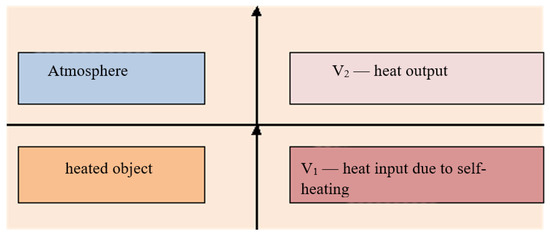
Figure 3.
Disturbance of balance (in the direction of heat dissipation) between heat input and heat output V1 > V2.
Natural materials often have a heterogeneous structure, consisting of multiple components [32,33]. This means that their properties, such as compensation temperatures and isentropic rates of spontaneous combustion, can vary significantly. Depending on its composition and structure, each material exhibits its own unique characteristics when certain temperature conditions are reached.
Self-ignition of peat deposits is a complex and dangerous process that can occur under certain conditions. When the rate of self-heating of peat soil exceeds the rate of its cooling, there is a threat of fire. This can occur not only at temperature extremes, but also when critical parameters such as moisture and oxygen content are reached. Humidity plays a key role in this process.
Once the moisture content in the peat soil layer attains specific levels, designated critical values, the process of ignition can be initiated. Concurrently, the presence of oxygen, either in the air or within the soil itself, functions as an oxidizing agent, thereby facilitating combustion. The prevailing conditions thus establish an optimal setting for the spontaneous combustion of peat deposits, a phenomenon with the potential to engender grave ramifications, encompassing substantial environmental and economic losses. It is, therefore, imperative to meticulously regulate and monitor these parameters, with a view to averting potential catastrophes.
Critical values of parameters in natural conditions arise when a number of natural conditions coincide, such as a high air temperature; low groundwater table and, as a consequence, lack of capillary feeding of the peat soil aeration zone; high oxygen content; and prolonged lack of precipitation during the fire hazard period.
Oxidation of solid materials’ surface, including organic materials, proceeds in two stages. First, oxygen molecules are sorbed on the surface of the solid material. Second, the oxygen valence electrons form chemical bonds with those of the material, the electrons are paired with donor and acceptor antiparallel spins, and they overcome the activation barrier. The valence electrons of the oxidizable material are relative to the oxygen sorbed on its surface, as if in a potential pit, and are distributed over the energy levels according to the exponential law.
The distribution parameter is the multiplication of R by Tx, where R is the universal constant, J/(mol/K), and Tx is the characteristic temperature of the distribution, in Kelvin. The higher the Tx, the lower the energy level of valence electrons in the less densely “populated” sublevels below the upper one. For the oxidizable material’s valence electrons to form strong pairs with oxygen electrons, they must leave a potential hole. The valence electrons pass from the upper energy levels to oxygen, which is sorbed on the surface with minimal energy losses, meeting the prerequisite for spontaneous ignition of solid organic substances.
Ignition from radiation occurs via the following steps: heat flux heats the surface to the ignition temperature , forming a self-heating zone. A wave of ignition (smoldering) is formed, capable of self-propagation. Oxygen initiates the oxidation process with polymer radicals’ formation:
R − H + O2 → R + HO2
This process is favored by high-temperature thermal and radioactive radiation. Radical R interacts with a new oxygen molecule:
R + O2 → ROO
The ROO radical is more active than R, so it reacts with the polymer and forms a new R:
ROO + RH → ROOH + R
Consequently, the oxidation chain develops according to the following dependence:
R + O2 → ROO
ROO + RH → ROOH + R
R + O2 → ROO
ROOH hydroperoxide interacts with the initial macromolecules of the hydrocarbon or polymer:
or decomposes through the O-O bond and forms the most active radicals OH and RO.
ROOH + RH → RO + R + H2O
Together with the branching of the chain, there is a break with the formation of stable products:
At the initial stage of chain formation and development, the reaction heat is spent on forming chemically active products (radicals, peroxides), so there is no self-heating of the reacting mass. Intensive heat generation occurs during rapid hydroperoxide decomposition; as the reaction is intensively self-accelerated, radicals actively interact with oxygen to form oxidation products (water):
OH + O2 → H2O + Q
The first oxidation stage, which proceeds without significant heating, is the induction period, and the second is the chain stage of oxidation. Ignition requires a combustible medium, oxidizer, and ignition source. In combustion physics, ignition is considered a physical phenomenon [34].
The initiation of combustion, whether in the ignition or self-ignition mode, is contingent upon the fulfillment of several pivotal conditions. Primarily, the presence of a combustible medium comprising a fuel and an oxidizing agent is requisite. The chemical reaction between these components engenders the conditions conducive to combustion. Secondly, the presence of energetic effects, emanating from diverse sources such as heat, spark or chemical reaction, is imperative. Finally, it is imperative that the thermophysical conditions favor a rapid release of heat that exceeds the rate of heat removal. Only if all these conditions are fulfilled is it possible to initiate and sustain the spontaneous combustion process.
In natural conditions, temperature reduction (cooling) in heated body areas occurs at different (non-uniform) rates. The criterion of non-uniformity of heating is determined by the following equation:
where is the difference between the temperatures of the heated material surface and the environment; and is the difference between the temperatures of the heated material thermophysical center and the environment
Thus, the conditions for the occurrence of spontaneous or forced ignition are created, and a reduction in the heating non-uniformity criterion is a prerequisite for starting the spontaneous ignition process.
The following equipment was used for our experimental studies:
- –
- Drying cabinet SNOL-3.5;
- –
- Thermocouples DTKP-0.5-4;
- –
- Eight-channel recorder meter OVEN;
- –
- OVEN software version 1.2;
- –
- ACZET CY-513 scales, accuracy 0.001 g;
- –
- Container made from a 30 × 30 mm brass net with a mesh of 0.8 mm.
The experimental setup is shown in Figure 4.
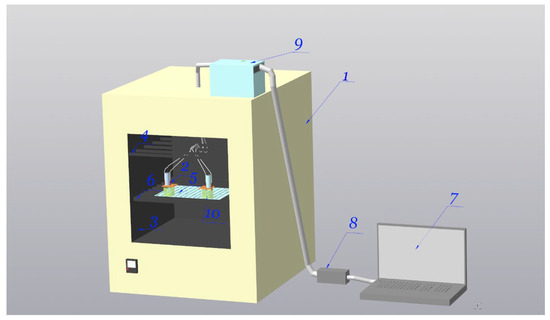
Figure 4.
Experimental setup. 1—SNOL—3.5,3.5,3.5/3.5-I1M—drying cabinet (350 °C, 42l, 350 × 350 × 350 mm, 2 kW, chamber steel); 2—thermoelectric converter DTPK 011-0.5/4; 3—heating chamber; 4—position locks DTPK; 5—mesh spacer; 6—sample shelf; 7—system ORM SCADA ORM V.1; 8—interface converter AC4-M; 9—analog input module MB110-224.8A; 10—container from a brass net 30 × 30 mm with a mesh of 0.8 mm.
Peat soil samples were collected at three locations of the Vasilievsky Mokh peat deposit. Point (single) samples were drilled from an elementary site, forming pooled samples, each with 20 point samples. The mass of the combined sample was over 1 kg.
The pooled samples were placed in boxes, labeled with the following information:
- (1)
- Region;
- (2)
- District;
- (3)
- Land category;
- (4)
- Pooled sample number;
- (5)
- Sample collection date;
- (6)
- Executor name;
- (7)
- Soil sampling standard.
The samples were collected during the day and dried in open boxes in a dry, well-ventilated room. To determine the natural moisture contents, samples were additionally placed in a box hermetically sealed with a lid.
Selected samples of peat, presented in Table 1, were loaded into containers (position 10, Figure 4), inside which thermocouples were placed, fixing the temperature of the thermophysical center and surface, as shown in Figure 5, of the peat placed in them, with an interval of 1 sec. These steps are recommended by VNIIPO (Fire Safety Research Institute) and GOST (National State Standard) 12.1.044-89 [35,36,37,38]. Spontaneous ignition occurred in the center of the test material (Figure 5) during the experimental studies.
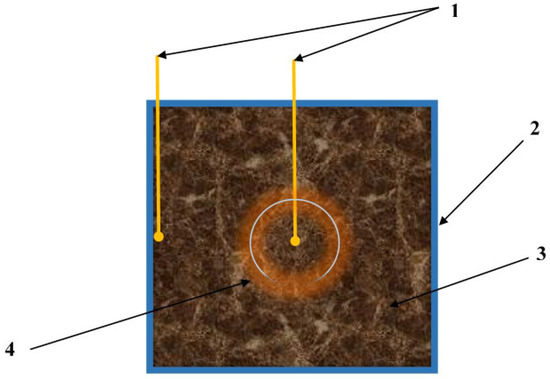
Figure 5.
Thermocouple placement in the container: 1—thermocouples; 2—brass net container with a mesh of 0.8 mm and a size of 30 × 30 mm; 3—peat samples; 4—place of spontaneous ignition in the smoldering mode.
Before the experiments, containers were filled with test material and weighed (minus the weight of the empty container, determined immediately before loading). When filling containers, the surface was carefully leveled. The container dimensions were measured with a sliding caliper with an accuracy of 0.5 mm. The filled containers were weighed, and then, the bulk density of peat was determined, which depended on the packing density of the container.
Figure 6 presents a photo of smoldering peat extracted from the experimental unit.
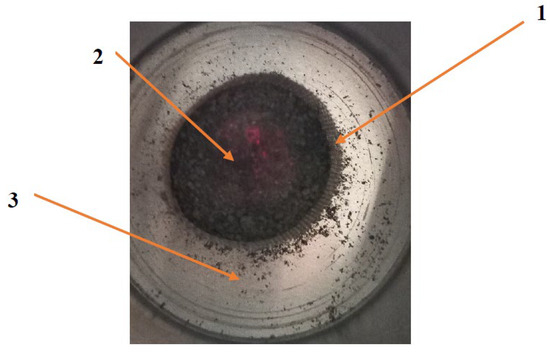
Figure 6.
Smoldering peat sample: 1—brass net container removed from the experimental unit; 2—smoldering hearth in the center of the peat sample in the container; 3—aluminum bucket where the container was unloaded from the experimental unit.
2.4. Statistical Analysis
The study revealed significant differences in the process of smoldering and changes in the state of peat samples that occurred over time, depending on their bulk density. The analysis was performed using the specialized statistical program OWEN-110-8A (Production Association OVEN LLC, Moscow, Russia).
3. Results
In our experimental studies, after a calibration experiment, the drying cabinet was kept at a given temperature for two hours and, if the readings of thermocouples remained unchanged, then, without adjustments, we proceeded with the tests. Two containers with prepared peat samples from one sampling location, according to Table 1 and Figure 2, but of different densities and thermocouples (Figure 5), were placed in the drying cabinet. The samples were kept there until the onset of spontaneous ignition. The appearance of smoke and a burning smell were considered to signify spontaneous combustion. As shown on all the given graphs of the dynamics of peat sample self-heating, smoldering occurred at extreme values (Figure 6). The samples were removed before the temperature exceeded 300 °C in the thermophysical center, to prevent damage to the installation. After removing the peat containers, the process continued until the samples burned completely, at an ambient temperature of 23 ± 3 °C in the laboratory. Figure 7, Figure 8, Figure 9, Figure 10, Figure 11, Figure 12, Figure 13 and Figure 14 show the average values of daily temperatures simulated in the experimental setup.
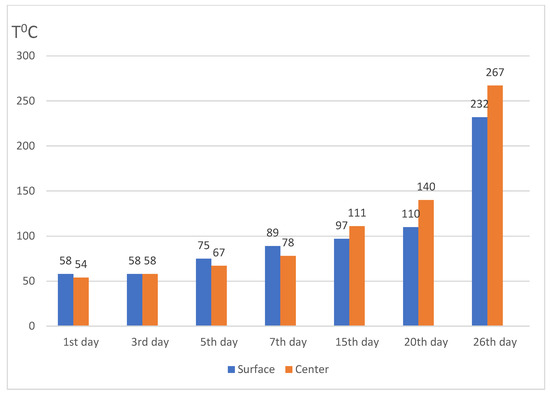
Figure 7.
Dynamics of self-heating of peat No. 1 with a density of 1 g/cm3 before the spontaneous ignition effect.
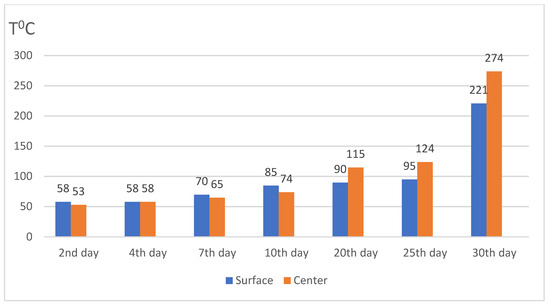
Figure 8.
Dynamics of self-heating of peat No. 1 with a density of 1.15 g/cm3 before the spontaneous ignition effect.

Figure 9.
Temperature change in peat soil sample No. 1 at night.
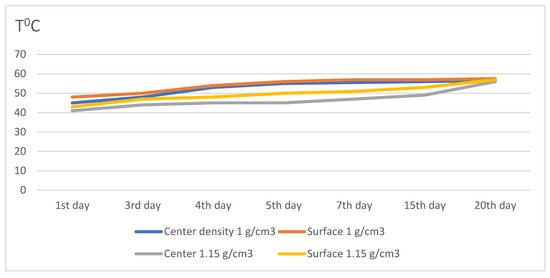
Figure 10.
Dynamics of heating peat sample No. 1 depending on density.

Figure 11.
Dynamics of self-heating of peat No. 2 with a density of 0.89 g/cm3.
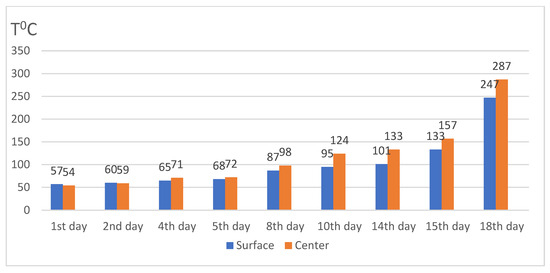
Figure 12.
Dynamics of self-heating of peat No. 2 with a density of 1.18 g/cm3 before the spontaneous ignition effect.
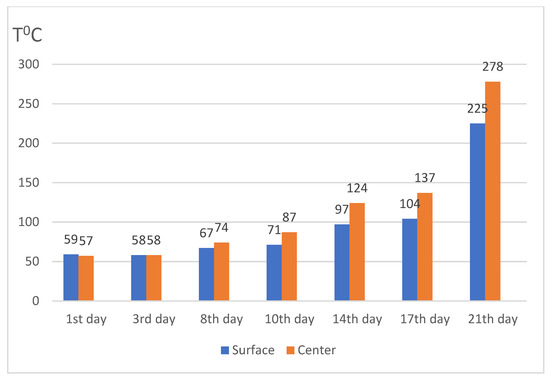
Figure 13.
Dynamics of self-heating of peat No. 3 with a density of 0.9 g/cm3 before the spontaneous ignition effect.
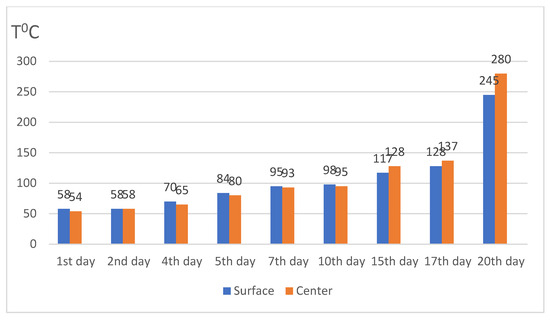
Figure 14.
Dynamics of self-heating of peat No. 3 with a density of 1.2 g/cm3 before the spontaneous ignition effect.
Based on the results presented in Figure 7 and Figure 8, for sample 1, it can be concluded that the time to spontaneous peat ignition increased with the bulk density (Figure 10). The initial peat moisture content was 36.05%, and the experiment was conducted at an ambient temperature of 58 °C. According to our research, the temperature of the soil surface in the summer can reach 75–85 °C. The experiment was conducted three times for each peat sample, according to the methodology developed by Dospekhov Boris A [39].
In the experiment, the drying cabinet temperature from 8–00 to 18–00 was maintained at 58 °C, and in the evening and nighttime, the temperature was 23 ± 3 °C, which corresponds to natural conditions. Figure 9 shows peat soil’s temperature change at night, that is, after the experimental setup was turned off, when the ambient temperature in the laboratory was 23 ± 3 °C. We can see that the denser sample kept a higher temperature than the less dense sample. The thermophysical centers in both variants were warmer than the ambient and surface temperatures of the samples, which indicates that the self-heating process occurred. Peat soils are considered cold, and an increase in peat density warms them, favoring agricultural crop cultivation. According to Figure 10, this effect was observed in our experimental studies with samples No. 2 and No. 3.
The simulation in the experimental setup of daytime temperatures of the peat soil surface, with heating up to 58 °C, showed that denser peat samples warmed more slowly than less dense ones (Figure 10), confirming that the peat soil fire hazard decreases as its volume weight increases, an effect observed for all samples regardless of their physical and chemical properties.
4. Discussion
4.1. Influence of Chemical Composition and Bulk Density on the Time of Occurrence of Peat Soil Spontaneous Ignition
The novel results of our research, the first of its kind, reflect how peat soil spontaneous ignition depends on the physicochemical composition and bulk density.
The experimental results show that samples’ self-heating chemical reactions led to smoldering at their centers.
The compositions of samples No. 2 and No. 3 were close in their total organic carbon and ash contents, but sample No. 2 was the most fire-hazardous because it had the highest sulfur content, confirming the data of Jan-Niklas Weber and others [40] from a study of forest fires in Germany.
A comparison of our experimental results revealed that an increase in peat density delayed the occurrence of spontaneous ignition.
The temperatures of denser peat samples were lower than those observed in less dense samples, indicating their lower fire hazard and possibility of spontaneous ignition, because the lower the density of the medium, the shorter the wavelength of combustion and the greater the oxidizer that is contained, resulting in a much higher combustion propagation rate. This supports the findings of similar research by Yuming Wen and others [41] on peat pyrolysis in laboratory conditions, as well as our earlier field research [42].
It can be concluded that with low decomposition, peat has a low bulk density and is thus enriched with oxygen, supporting the rapid formation of a self-propagating combustion wave and reducing the peat soil top-layer ignition time.
4.2. Proposal of Measures to Reduce Peat Soil’s Risk of Spontaneous Ignition
Drained peatlands after peat mining are the most hazardous. In these settings, it is common practice to leave a 60–70 cm residual peat layer for subsequent use. In these conditions, the technological operations required to change the volumetric density of the peat layer using a complex of machines are as shown in Figure 15.
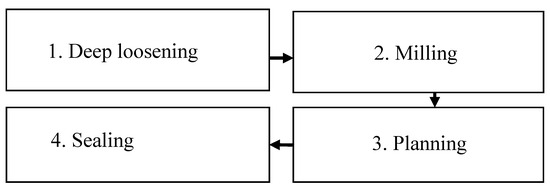
Figure 15.
Technological operations for sealing peat soil.
Purposes of technological operations: 1—deep plowing of the peatland at 60–70 cm in order to loosen the compacted part of the underlying soil, which according to our data is 10 cm deep and prevents moisture from entering the upper layers for capillary supply from the groundwater, and when removed allows for capillary bonds with the peat layer; 2—milling the peatland surface at 15–20 cm to mix the upper fire hazard 5 cm layer with denser underlying layers in order to create a denser layer; 3—surface leveling to increase the efficiency of the subsequent rolling of the peat layer, to increase its density (this operation reduces evaporation from the field surface by up to 20% in a warm period by reducing the contact area between the field and atmospheric air); and 4—sealing the milled peat layer to reduce its fire hazard, which is suitable for the biological (agricultural) stage of recultivation and creates capillary connections with the underlying layers.
The above technological operations were tested on a 10 ha plot in the Tver region, with a 50 cm peat layer thickness. The location of the plot is shown in Figure 1.
Peat soil depth densities before the treatment are presented in Figure 16, and those after the treatment are given in Figure 17.

Figure 16.
Depth variation in the density of excavated peatland not recultivated.
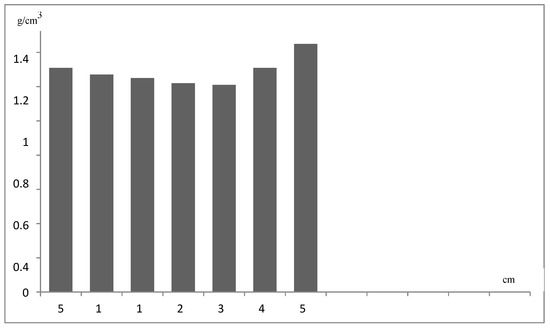
Figure 17.
Peat density by depth after the full cycle of the technical stage of reclamation.
5. Conclusions
Our complex experiments involved the simultaneous study of the influences of chemical element contents and oxygen saturation in peat samples on the soil fire hazard, depending on the bulk density and regardless of the peat composition.
The obtained dependences on the bulk density and sulfur and carbon contents in peat samples allow us to propose means of reducing the peat fire risk in the hazardous summer period by means of technological intervention.
Chiefly, in this research, we integrated information on the thermophysical processes of spontaneous combustion and forced ignition of solid dispersed, porous, and fibrous organic materials, to which peat soil belongs. We also explored the opportunities for agrotechnology in agricultural crop cultivation, to adjust peat’s thermophysical parameters, prevent its accumulation of excessive heat, and avoid the occurrence of peat fires. In the future, gaining further knowledge of the impacts of peat soil treatment via agrotechnical methods, its chemical composition, its degree of decomposition, and its physical characteristics on the processes of spontaneous and forced thermal ignition will lead to interventions that lower the peat fire risk and subsequent environmental and economic damage.
Author Contributions
Conceptualization, O.N.D. and A.V.E.; methodology, A.V.E.; software, A.V.K.; validation, O.N.D., A.V.E. and N.N.P.; formal analysis, A.S.G.; investigation, A.V.E.; resources, O.N.D.; data curation, A.S.G.; writing—original draft preparation, A.V.E.; writing—review and editing, A.S.G.; visualization, A.V.K.; supervision, O.N.D.; project administration, N.N.P.; funding acquisition, O.N.D. All authors have read and agreed to the published version of the manuscript.
Funding
The research was carried with a grant from the Russian Science Foundation No. 24-16-00081 (URL: https://rscf.ru/project/24-16-00081/ Date of access 7 May 2024).
Institutional Review Board Statement
Not applicable.
Informed Consent Statement
Not applicable.
Data Availability Statement
The raw data supporting the conclusions of this article will be made available by the authors on request.
Conflicts of Interest
The authors declare no conflicts of interest.
References
- Andronova, A.V.; Artamonova, M.S.; Iordansky, M.A.; Ginzburg, A.S.; Granberg, I.G.; Minashkin, V.M.; Obvintsev, Y.I.; Trefilova, A.V. Disperse composition and content of chemical elements in aerosols of the surface layer of the atmosphere of Moscow. Life Saf. 2010, 9, 47–51. (In Russian) [Google Scholar]
- Isaeva, L.K.; Sulimenko, V.A.; Sulimenko, S.V.; Solovyov, S.V. Health assessment of firefighters in connection with the effect of toxic combustion products on the respiratory organs. Vestn. Acad. State Fire Fight. Serv. 2005, 3, 73–81. (In Russian) [Google Scholar]
- Isaeva, L.K.; Vlasov, A.G.; Solovyov, S.V. Investigation of peat properties in the development of preventive measures and methods of peat fire extinguishing. Vestn. Acad. State Fire Fight. Serv. Minist. Emerg. Situat. Russ. 2004, 2, 52–60. (In Russian) [Google Scholar]
- Isaeva, L.K.; Solovyov, S.V.; Sulimenko, V.A.; Shilin, S.A. Ecological consequences of forest and peat fires in the Moscow region in 2002–2009. Fires Emerge. Prev. Elimin. 2010, 3, 85–91. (In Russian) [Google Scholar]
- Dietze, E.; Theuerkauf, M.; Bloom, K.; Brauer, A.; Dörfler, W.; Feeser, I.; Feurdean, A.; Gedminiene, L.; Giesecke, T.; Jahns, S.; et al. Holocene fire activity during low-natural flammabilityperiods reveals scale-dependent cultural human-fire relationships in Europe. Quat. Sci. Rev. 2018, 201, 44–56. [Google Scholar] [CrossRef]
- Voroshilov, I.V. Innovative methods to ensure fire safety of peatlands, steppe and forest areas. In VI International Book Edition of the Commonwealth of Independent States “The Best Young Scientist—2022”; Voroshilov, I.V., Belozerov, V.V., Eds.; Association of Legal Entities in the Form of Association “Nationwide Movement “Bobek”: Astana, Kazakhstan, 2022; Volume IX, pp. 9–14. (In Russian) [Google Scholar]
- Kurakov, F.A. Technologies for extinguishing landscape fires as a possible scientific and technological priority of the Russian Federation. Econ. Sci. 2017, 3, 214–226. (In Russian) [Google Scholar] [CrossRef]
- Matt Jolly, W.; Freeborn, P.H.; Bradshaw, L.S.; Wallace, J.; Brittain, S. Modernizing the US National Fire Danger Rating System (version 4): Simplified fuel models and improved live and dead fuel moisture calculations. Environ. Model. Softw. 2024, 181, 106181. [Google Scholar] [CrossRef]
- Karachevsky, A.E. Using modern geoinformation systems to analyze the risk of fires. In Far East: Problems of Development of Architectural and Construction Complex; Karachevsky, A.E., Mishkin, D.V., Eds.; Pacific National University: Khabarovsk, Russia, 2022; Volume 1, pp. 257–261. (In Russian) [Google Scholar]
- Sim, T.G.; Swindles, G.T.; Baird, A.J.; Gallego-Sala, A.V.; Wang, Y.; Blaauw, M.; Camill, P.; Garneau, M.; Hardiman, M.; Loisel, J.; et al. Regional variability in peatland burning at mid-to high-latitudes during the Holocene. Quat. Sci. Rev. 2023, 305, 108020. [Google Scholar] [CrossRef]
- de Groot, B.W.J.; Wotton, M.; Flannigan, M.D. Chapter 11—Wildland Fire Danger Rating and Early Warning System. In Wildfire Hazards, Risks and Disasters; Shroder, J.F., Paton, D., Eds.; Elsevier: Amsterdam, The Netherlands, 2015; pp. 207–228. ISBN 9780124104341. [Google Scholar] [CrossRef]
- Volokitina, A.V.; Sofronova, T.M. Mapping of vegetative combustible materials. Sib. For. J. 2014, 6, 8c28. (In Russian) [Google Scholar]
- Jahangir, M.H.; Hosseindoost, M.S.; Arast, M. Assessment of drought condition in Guilan Province using the Keetch-Byram Drought Index (KBDI) in accordance with the Percent of Normal Precipitation Index (PNPI). Water Soil Manag. Model. 2021, 1, 57–67. [Google Scholar] [CrossRef]
- Potter, B.E.; Winkler, J.A.; Wilhelm, D.F.; Shadbolt, R.P.; Bian, X. Computing the Low-Elevation Variant of the Haines Index for Fire Weather Forecasts. Weather Forecast. 2008, 23, 159–167. [Google Scholar] [CrossRef]
- Nesterov, V.G. Forest Burning and Methods of Its Determination; Goslesbumizdat: Moscow, Russia, 1949; 76p. [Google Scholar]
- Sokolova, G.V.; Teteryatnikova, E.P. Problems of Long-Term Forecasting of Fire Danger in the Forests of Khabarovsk Krai and Jewish Autonomous Region by Meteorological Conditions; Edition DVO RAS: Khabarovsk, Russia, 2008; 150p. (In Russian) [Google Scholar]
- Wolton, M. Interpreting and using outputs from the Canadian Forest Fire Danger Rating System in research applications. Environ. Ecol. Stat. 2009, 16, 107–131. [Google Scholar] [CrossRef]
- Stocks, B.J.; Lynham, T.J.; Lawson, B.D.; Alexander, M.E.; Van Wagner, C.E.; McAlpine, R.S.; Dubé, D.E. The Canadian Forest Fire Danger Rating System: An Overview. For. Chron. 1989, 65, 450–457. [Google Scholar] [CrossRef]
- Bento, V.A.; Lima, D.C.; Santos, L.C.; Lima, M.M.; Russo, A.; Nunes, S.A.; DaCamara, C.C.; Trigo, R.M.; Soares, P.M. The future of extreme meteorological fire danger under climate change scenarios for Iberia. Weather Clim. Extrem. 2023, 42, 100623. [Google Scholar] [CrossRef]
- Bar, S.; Parida, B.R.; Pandey, A.C.; Shankar, B.U.; Kumar, P.; Panda, S.K.; Behera, M.D. Modeling and prediction of fire occurrences along an elevational gradient in Western Himalayas. Appl. Geogr. 2023, 151, 102867. [Google Scholar] [CrossRef]
- Van Vliet, L.; Fyke, J.; Nakoneczny, S.; Murdock, T.Q.; Jafarpur, P. Developing user-informed fire weather projections for Canada. Clim. Serv. 2024, 35, 100505. [Google Scholar] [CrossRef]
- Musa, D.; Afat, R.; Gilbert, M.; Kamlun, K. HEAT CONTENT AND BURNING TIME OF TROPICAL PEAT. Borneo J. Resour. Sci. Technol. 2020, 41, 68–74. [Google Scholar] [CrossRef]
- Venmans, F.; Carr, B. Literature-informed likelihoods of future emissions and temperatures. Clim. Risk Manag. 2024, 44, 100605. [Google Scholar] [CrossRef]
- Jolly, W.M.; Freeborn, P.H.; Page, W.G.; Butler, B.W. Severe fire danger index: A forecastable metric to inform firefighter and community wildfire risk management. Fire 2019, 2, 47. [Google Scholar] [CrossRef]
- Cawson, J.G.; Collins, L.; Parks, S.A.; Nolan, R.H.; Penman, T.D. Atmospheric dryness removes barriers to the development of large forest fires. Agric. For. Meteorol. 2024, 350, 109990. [Google Scholar] [CrossRef]
- Bahrepour, M.; Meratnia, N.; Havinga, P.J.M. Automatic Fire Detection: A Survey from Wireless Sensor Network Perspective; CTIT Technical Report Series; No. WoTUG-31/TR-CTIT-08-73; Centre for Telematics and Information Technology (CTIT): Enschede, The Netherlands, 2008. [Google Scholar]
- Noble, I.R.; Bary, G.A.V.; Gill, A.M. McArthur’s fire-danger meters expressed as equations. Aust. J. Ecol. 2006, 5, 201–203. [Google Scholar] [CrossRef]
- Lin, S.; Zhang, T.; Huang, X.; Gollner, M.J. The initiation of smouldering peat fire by a glowing firebrand. Int. J. Wildland Fire 2024, 33, WF23116. [Google Scholar] [CrossRef]
- Zaidelman, F.R. Hydrogeological Regime of Soils of the Non-Chernozem Zone; Gidrometeoizdat: Leningrad, Russia, 1985; 328p. (In Russian) [Google Scholar]
- Panov, V.V. Structure and Accounting of Fire-Hazardous Peat Bogs in the Tver Region; Panov, V.V., Zhenikhov, Y.N., Eds.; Works of Instorf; Peat Industry Institute: Saint Petersburg, Russia, 2021; Volume 24, pp. 26–33. (In Russian) [Google Scholar]
- Muravyeva, L.V. Fire Spreading and Its Impact on the Development of Natural-Anthropogenic Complexes of the Bog; Vasilievsky Mokh. Vestnik TvGU; Series: Geography and Geoecology; Tver State University: Tver, Russia, 2023; pp. 47–55. (In Russian) [Google Scholar] [CrossRef]
- Frandsen, W.H. Ignition probability of organic soils. Can. J. For. Res. 1997, 27, 1471–1477. [Google Scholar] [CrossRef]
- Glaser, P.H.; Hansen, B.C.S.; Siegel, D.I.; Reeve, A.S.; Morin, P.J. Rates, pathways and drivers for peatland development in the Hudson Bay Lowlands, northern Ontario, Canada. J. Ecol. 2004, 92, 1036–1053. [Google Scholar] [CrossRef]
- Didmanidze, O.N.; Parlyuk, E.P.; Evgrafov, A.V. Results of studies of the temperature regime of drained peat soil. Agroengineering 2023, 25, 45–49. (In Russian) [Google Scholar] [CrossRef]
- Borisov, A.A. Experimental researches and mathematical modeling of peat fires. In Teplophysics of Forest Fires; Borisov, A.A., Borisov, A.A., Gorelik, R.S., Eds.; Nauka: Novosibirsk, Russia, 1984; pp. 5–22. (In Russian) [Google Scholar]
- Borisov, A.A.; Kiselev, Y.S.; Udilov, V.P. Kinetic characteristics of low-temperature burning of peat. In Teplophysics of Forest Fires; ITFSO AS USSR: Novosibirsk, Russia, 1984; pp. 23–30. (In Russian) [Google Scholar]
- Veselovsky, V.S.; Alekseeva, N.D.; Vinogradova, L.P.; Orleanskaya, G.L.; Terpogosova, E.A. Spontaneous Ignition of Industrial Materials; Nauka: Moscow, Russia, 1964; 246p. (In Russian) [Google Scholar]
- Kiselev, Y.S. Regularity of stationary distribution of active centers in self-heating materials, solid materials by energy levels. In Safety and Ecology of Saint-Petersburg; SPbGTU Edition: Moscow, Russia, 1999; pp. 299–302. (In Russian) [Google Scholar]
- Dospekhov, B.A. Methods of Field Experiment: (With the Basics of Statistical Processing of Research Results): Textbook for Students of Higher Agricultural Educational Institutions in Agronomic Specialties, 6th ed.; 1985, reprinted from the 5th ed.; Dospekhov, B.A., Ed.; Alliance: Moscow, Russia, 2011; Available online: https://drive.google.com/file/d/0B5KiBwgHRtwjekJrRjdZcnJuNEk/view?resourcekey=0-T95jYNweQc3qAO6mEEbnfg (accessed on 2 December 2024). (In Russian)
- Weber, J.-N.; Kaufholdt, D.; Minner-Meinen, R.; Bloem, E.; Shahid, A.; Rennenberg, H.; Hänsch, R. Impact of wildfires on SO2 detoxification mechanisms in leaves of oak and beech trees. Environ. Pollut. 2021, 272, 116389. [Google Scholar] [CrossRef]
- Wen, Y.; Wang, S.; Mu, W.; Yang, W.; Jönsson, P.G. Pyrolysis performance of peat moss: A simultaneous in-situ thermal analysis and bench-scale experimental study. Fuel 2020, 277, 118173. [Google Scholar] [CrossRef]
- Didmanidze, O.N.; Akademiâ, T.S.; Evgrafov, A.V. Influence of peat soil density on the occurrence of landscape fires. Environ. Manag. 2022, 4, 37–41. (In Russian) [Google Scholar] [CrossRef]
Disclaimer/Publisher’s Note: The statements, opinions and data contained in all publications are solely those of the individual author(s) and contributor(s) and not of MDPI and/or the editor(s). MDPI and/or the editor(s) disclaim responsibility for any injury to people or property resulting from any ideas, methods, instructions or products referred to in the content. |
© 2025 by the authors. Licensee MDPI, Basel, Switzerland. This article is an open access article distributed under the terms and conditions of the Creative Commons Attribution (CC BY) license (https://creativecommons.org/licenses/by/4.0/).